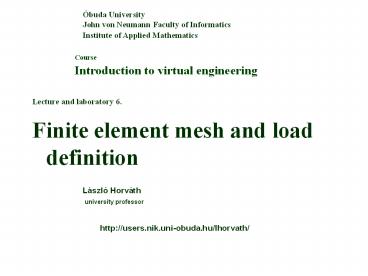1. dia PowerPoint PPT Presentation
1 / 35
Title: 1. dia
1
Óbuda University John von Neumann Faculty of
Informatics Institute of Applied Mathematics
Course Introduction to virtual engineering
Lecture and laboratory 6. Finite element mesh
and load definition
László Horváth university professor
http//users.nik.uni-obuda.hu/lhorvath/
2
Contents
Lecture
Concept of finite element analysis
Completing part models for finite element
analysis
Finite elements and placing loads for analysis
Concept of associative, parametric, and adaptive
mesh
Laboratory
Introduction by studying typical FEA tasks
(VE6.1/a-b)
Creating and studying finite element mesh on a
spatial surface (VE6.2)
László Horváth ÓU-IAM
http//users.nik.uni-obuda.hu/lhorvath/
3
Concept of finite element analysis
Approximation of location dependent parameters as
design variables acting on the design
performance on a finite number of finite elements
Finite Element Modeling (FEM) creates extended
part and assembly model for Finite Element
Analysis (FEA)
A numerical method
László Horváth ÓU-IAM
http//users.nik.uni-obuda.hu/lhorvath/
4
Completing part models for finite element
analysis (preprocessing)
László Horváth ÓU-IAM
http//users.nik.uni-obuda.hu/lhorvath/
5
Finite elements and placing loads for analysis
Mesh
Elements
László Horváth ÓU-IAM
http//users.nik.uni-obuda.hu/lhorvath/
6
Finite elements modeling
This FEM/FEA modeling and analysis are done as
Laboratory task VE6.1/a. Part modeling is
included in .ppt for lecture 8.
László Horváth ÓU-IAM
http//users.nik.uni-obuda.hu/lhorvath/
7
Finite elements modeling
László Horváth ÓU-IAM
http//users.nik.uni-obuda.hu/lhorvath/
8
Finite elements and placing loads for analysis
Several frequently applied loads Concentrated and
distributed force. Torque. Contact
pressure. Acceleration (gravity, translation,
rotation). Temperature on surface. Concentrated
or distributed heat source. Magnetic.
Placing loads and restraints Making simulation
of real operating conditions possible. On mesh
(at nodes). On geometry of the part (along lines
and on surfaces). Mathematical
expressions. Automatic contact recognition.
Boundary conditions Mechanical restraints
restrict movements in specified directions and
result reaction forces. Definition of degrees of
freedom. Non-restrained nodes have six degrees of
freedom.
László Horváth ÓU-IAM
http//users.nik.uni-obuda.hu/lhorvath/
9
Placing clamp restraint (DOF0) on geometry
László Horváth ÓU-IAM
http//users.nik.uni-obuda.hu/lhorvath/
10
Placing bearing load on geometry
László Horváth ÓU-IAM
http//users.nik.uni-obuda.hu/lhorvath/
11
Placing distributed force load on geometry
László Horváth ÓU-IAM
http//users.nik.uni-obuda.hu/lhorvath/
12
Compute the model
László Horváth ÓU-IAM
http//users.nik.uni-obuda.hu/lhorvath/
13
Compute the model
László Horváth ÓU-IAM
http//users.nik.uni-obuda.hu/lhorvath/
14
Concept of associative, parametric, and adaptive
mesh
Two-way associative connection between shape
model and mesh for automatic change of the mesh
in case of changed geometry. Mesh is
characterized by parameters mainly for the
definition of its dimensions. Adaptive mesh
definition is an automatic modification of mesh
density, element order, and element shape.
Density can vary according to the load on each
region.
László Horváth ÓU-IAM
http//users.nik.uni-obuda.hu/lhorvath/
15
Visualize the mesh
László Horváth ÓU-IAM
http//users.nik.uni-obuda.hu/lhorvath/
16
Definition of solution and visualize color ranges
László Horváth ÓU-IAM
http//users.nik.uni-obuda.hu/lhorvath/
17
Visualize with and without deformation
László Horváth ÓU-IAM
http//users.nik.uni-obuda.hu/lhorvath/
18
Nodal values details from different regions of
the solid
László Horváth ÓU-IAM
http//users.nik.uni-obuda.hu/lhorvath/
19
Finite element modeling and analysis
Laboratory task VE6.1/b.
László Horváth ÓU-IAM
http//users.nik.uni-obuda.hu/lhorvath/
20
Definition of a mechanical part to be analyzed
Slides 8-13 show main steps of the part
definition. If you can not understand the
definition process, please refer to relevant
slide shows for the previous lectures or to the
lecturer.
Laboratory task VE6.2 includes definition of this
part.
László Horváth ÓU-IAM
http//users.nik.uni-obuda.hu/lhorvath/
21
Definition of a mechanical part to be analyzed
László Horváth ÓU-IAM
http//users.nik.uni-obuda.hu/lhorvath/
22
Definition of a mechanical part to be analyzed
László Horváth ÓU-IAM
http//users.nik.uni-obuda.hu/lhorvath/
23
Definition of a mechanical part to be analyzed
László Horváth ÓU-IAM
http//users.nik.uni-obuda.hu/lhorvath/
24
Definition of a mechanical part to be analyzed
László Horváth ÓU-IAM
http//users.nik.uni-obuda.hu/lhorvath/
25
Definition of a mechanical part to be analyzed
László Horváth ÓU-IAM
http//users.nik.uni-obuda.hu/lhorvath/
26
Definition of load and restraint in Finite
Element Model (FEM)
Laboratory task VE6.1/b includes definition of
the subsequent FEM and FEA model.
László Horváth ÓU-IAM
http//users.nik.uni-obuda.hu/lhorvath/
27
Visualization of mesh in Finite Element Model
(FEM)
László Horváth ÓU-IAM
http//users.nik.uni-obuda.hu/lhorvath/
28
Finite Element Analysis (FEM)
László Horváth ÓU-IAM
http//users.nik.uni-obuda.hu/lhorvath/
29
Introduction by studying typical FEA tasks
Source www.catia.com
László Horváth ÓU-IAM
http//users.nik.uni-obuda.hu/lhorvath/
30
Introduction by studying typical FEA tasks
Source www.catia.com
László Horváth ÓU-IAM
http//users.nik.uni-obuda.hu/lhorvath/
31
Creating and studying finite element mesh on a
spatial surface
Laboratory task VE6.2
László Horváth ÓU-IAM
http//users.nik.uni-obuda.hu/lhorvath/
32
Creating and studying finite element mesh on a
spatial surface
László Horváth ÓU-IAM
http//users.nik.uni-obuda.hu/lhorvath/
33
Creating and studying finite element mesh on a
spatial surface
László Horváth ÓU-IAM
http//users.nik.uni-obuda.hu/lhorvath/
34
Creating and studying finite element mesh on a
spatial surface
László Horváth ÓU-IAM
http//users.nik.uni-obuda.hu/lhorvath/
35
Creating and studying finite element mesh on a
spatial surface
László Horváth ÓU-IAM
http//users.nik.uni-obuda.hu/lhorvath/

